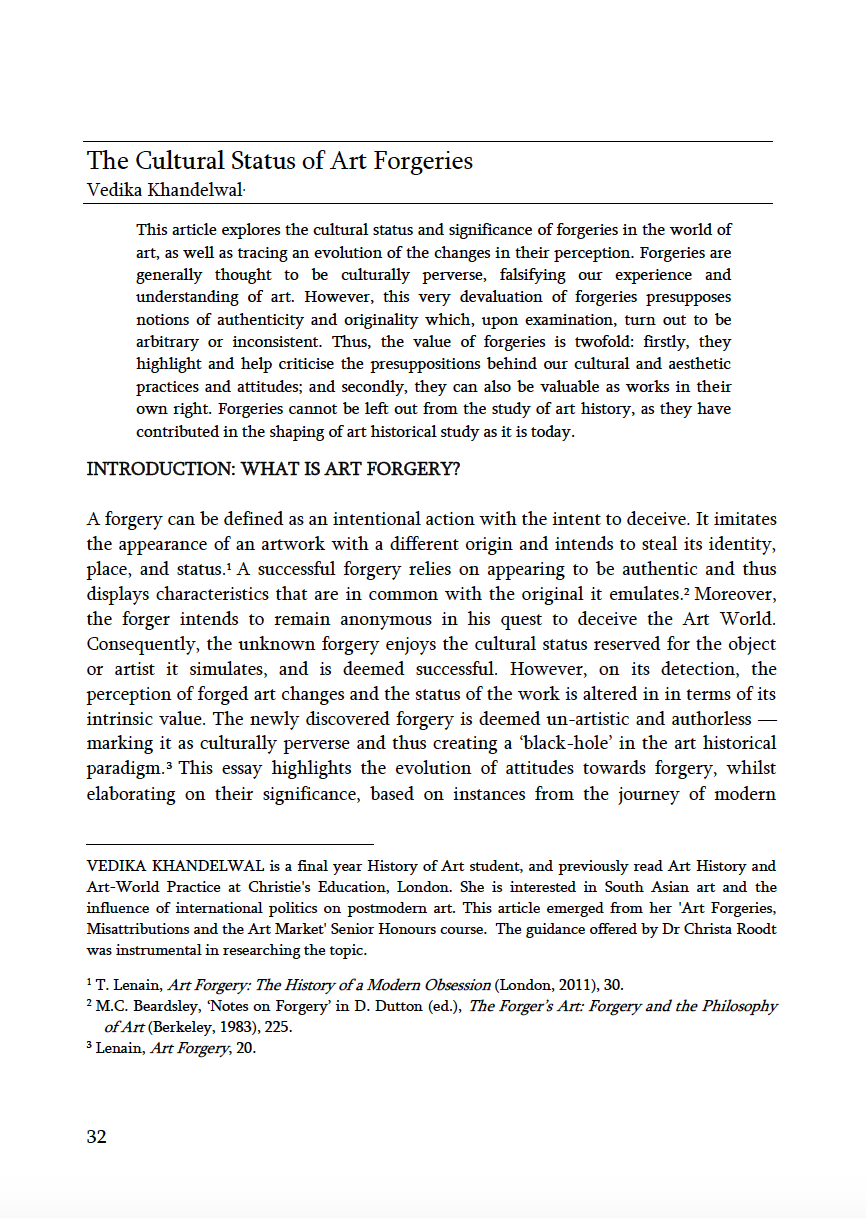The Cultural Status of Art Forgeries
DOI:
https://doi.org/10.36399/GroundingsUG.8.206Keywords:
Forgery, Devaluation, Authenticity, Aesthetic, Attitudes, Contribution, ValidityAbstract
This article explores the cultural status and significance of forgeries in the world of art, as well as tracing an evolution of the changes in their perception. Forgeries are generally thought to be culturally perverse, falsifying our experience and understanding of art. However, this very devaluation of forgeries presupposes notions of authenticity and originality which, upon examination, turn out to be arbitrary or inconsistent. Thus, the value of forgeries is twofold: firstly, they highlight and help criticise the presuppositions behind our cultural and aesthetic practices and attitudes; and secondly, they can also be valuable as works in their own right. Forgeries cannot be left out from the study of art history, as they have contributed in the shaping of art historical study as it is today.
References
M. C. Beardsley, ‘Notes on Forgery’ in D. Dutton (ed.), The Forger’s Art: Forgery and the Philosophy of Art (Berkeley, 1983), 225-231.
R. Bowden, ‘What Is Wrong with an Art Forgery?: An Anthropological Perspective’ (1999) 57:3 The Journal of Aesthetics and Art Criticism 333-343.
A. Briefel, ‘Sacred Objects/Illusionary Idols: The Fake in Freud’s “The Moses of Michelangelo”’ in P. Knight & J. Long (eds.), Fakes and Forgeries (Newcastle upon Thames, 2005), 29-40.
L. B. Cebik, ‘On the Suspicion of an Art Forgery’ (1989) 47:2 The Journal of Aesthetics and Art Criticism 147-156.
E. Dolnick, The Forger's Spell: a True Story of Vermeer, Nazis, and the Greatest Art Hoax of the Twentieth Century (New York; London, 2008).
N. Goodman, ‘Art and Authenticity’ in D. Dutton (ed.), The Forger’s Art: Forgery and the Philosophy of Art (Berkeley, 1983), 78-93.
M. Jones, ‘Why Fakes?’ in M. Jones (ed.), Fakes: The Art of Deception (London, 1990), 11-16.
J. Keats, Forged: Why Fakes are the Great Art of Our Age (New York, 2013).
A. Koestler, ‘The Anatomy of Snobbery’ in The Trail of the Dinosaur and other Essays, (New York, 1995), 69-94.
T. Lenain, Art Forgery: The History of a Modern Obsession (London, 2011).
A. Lessing, ‘What is Wrong with a Forgery?’ in in D. Dutton (ed.), The Forger’s Art: Forgery and the Philosophy of Art (Berkeley, 1983), 58-76.
D. Lowenthal, ‘Forging the Past’ in M. Jones (ed.), Fakes: The Art of Deception (London, 1990), 16-22.
D. Lowenthal, ‘Authenticity? The Dogma of Self Destruction’ in M. Jones (ed.), Why Fakes Matter: Essays on Problems of Authenticity (London, 1992), 184-192.
D. Lowenthal, ‘Counterfeit Art: Authentic Fakes?’ (1992) 1:1 International Journal of Cultural Property 79-104.
L. B. Meyer, ‘Forgery and the Anthropology of Art’ in D. Dutton (ed.), The Forger’s Art: Forgery and the Philosophy of Art (Berkeley, 1983), 77-93.
P.F. Norton, ‘The Lost Sleeping Cupid of Michelangelo’ (1957) 39:4 The Art Bulletin 251-257.

Downloads
Published
Issue
Section
License
Copyright (c) 2015 Vedika Khandelwal

This work is licensed under a Creative Commons Attribution 4.0 International License.
The CC BY 4.0 license is a Creative Commons license. This is a non-copyleft free license that is good for art and entertainment works, and educational works. It is compatible with all versions of the GNU GPL; however, like all CC licenses, it should not be used on software. People are free to: Share — copy and redistribute the material in any medium or format; Adapt — remix, transform, and build upon the material for any purpose, even commercially. The licensor cannot revoke these freedoms as long as you follow the license terms. But they must conform to the following terms: Attribution — You must give appropriate credit, provide a link to the license, and indicate if changes were made. You may do so in any reasonable manner, but not in any way that suggests the licensor endorses you or your use. No additional restrictions — You may not apply legal terms or technological measures that legally restrict others from doing anything the license permits.
Please check individual article PDF copies to see if any additional restrictions apply.







